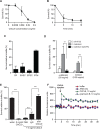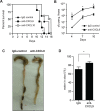CXCL9 contributes to antimicrobial protection of the gut during citrobacter rodentium infection independent of chemokine-receptor signaling
- PMID: 25643352
- PMCID: PMC4333760
- DOI: 10.1371/journal.ppat.1004648
CXCL9 contributes to antimicrobial protection of the gut during citrobacter rodentium infection independent of chemokine-receptor signaling
Abstract
Chemokines have been shown to be effective bactericidal molecules against a variety of bacteria and fungi in vitro. These direct antimicrobial effects are independent of their chemotactic activities involving immunological receptors. However, the direct biological role that these proteins may play in host defense, particularly against intestinal pathogens, is poorly understood. Here, we show that CXCL9, an ELR- chemokine, exhibits direct antimicrobial activity against Citrobacter rodentium, an attaching/effacing pathogen that infects the gut mucosa. Inhibition of this antimicrobial activity in vivo using anti-CXCL9 antibodies increases host susceptibility to C. rodentium infection with pronounced bacterial penetration into crypts, increased bacterial load, and worsened tissue pathology. Using Rag1(-/-) mice and CXCR3(-/-) mice, we demonstrate that the role for CXCL9 in protecting the gut mucosa is independent of an adaptive response or its immunological receptor, CXCR3. Finally, we provide evidence that phagocytes function in tandem with NK cells for robust CXCL9 responses to C. rodentium. These findings identify a novel role for the immune cell-derived CXCL9 chemokine in directing a protective antimicrobial response in the intestinal mucosa.
Conflict of interest statement
The authors have declared that no competing interests exist.
Figures





Similar articles
-
CXCR2-dependent mucosal neutrophil influx protects against colitis-associated diarrhea caused by an attaching/effacing lesion-forming bacterial pathogen.J Immunol. 2009 Sep 1;183(5):3332-43. doi: 10.4049/jimmunol.0900600. Epub 2009 Aug 12. J Immunol. 2009. PMID: 19675161 Free PMC article.
-
Epithelial phosphatidylinositol-3-kinase signaling is required for β-catenin activation and host defense against Citrobacter rodentium infection.Infect Immun. 2011 May;79(5):1863-72. doi: 10.1128/IAI.01025-10. Epub 2011 Feb 22. Infect Immun. 2011. PMID: 21343355 Free PMC article.
-
Citrobacter rodentium-induced colitis: A robust model to study mucosal immune responses in the gut.J Immunol Methods. 2015 Jun;421:61-72. doi: 10.1016/j.jim.2015.02.003. Epub 2015 Feb 19. J Immunol Methods. 2015. PMID: 25702536
-
T cell subsets and environmental factors in Citrobacter rodentium infection.Curr Opin Microbiol. 2021 Oct;63:92-97. doi: 10.1016/j.mib.2021.06.006. Epub 2021 Jul 21. Curr Opin Microbiol. 2021. PMID: 34298480 Review.
-
Group 3 innate lymphoid cells mediate host defense against attaching and effacing pathogens.Curr Opin Microbiol. 2021 Oct;63:83-91. doi: 10.1016/j.mib.2021.06.005. Epub 2021 Jul 15. Curr Opin Microbiol. 2021. PMID: 34274597 Review.
Cited by
-
Resident macrophages acquire innate immune memory in staphylococcal skin infection.Elife. 2020 Jul 8;9:e55602. doi: 10.7554/eLife.55602. Elife. 2020. PMID: 32639232 Free PMC article.
-
Sensory Nociceptive Neurons Contribute to Host Protection During Enteric Infection With Citrobacter rodentium.J Infect Dis. 2020 Jun 11;221(12):1978-1988. doi: 10.1093/infdis/jiaa014. J Infect Dis. 2020. PMID: 31960920 Free PMC article.
-
Gut microbiota, circulating inflammatory markers and metabolites, and carotid artery atherosclerosis in HIV infection.Microbiome. 2023 May 27;11(1):119. doi: 10.1186/s40168-023-01566-2. Microbiome. 2023. PMID: 37237391 Free PMC article.
-
Interleukin 21 collaborates with interferon-γ for the optimal expression of interferon-stimulated genes and enhances protection against enteric microbial infection.PLoS Pathog. 2019 Feb 28;15(2):e1007614. doi: 10.1371/journal.ppat.1007614. eCollection 2019 Feb. PLoS Pathog. 2019. PMID: 30818341 Free PMC article.
-
Inflammation promotes stomach epithelial defense by stimulating the secretion of antimicrobial peptides in the mucus.Gut Microbes. 2024 Jan-Dec;16(1):2390680. doi: 10.1080/19490976.2024.2390680. Epub 2024 Sep 8. Gut Microbes. 2024. PMID: 39244776 Free PMC article.
References
-
- Yang D (2003) Many chemokines including CCL20/MIP-3 display antimicrobial activity. J Leukocyte Biol 74: 448–455. - PubMed
-
- Cole AM, Ganz T, Liese AM, Burdick MD, Liu L, et al. (2001) Cutting edge: IFN-inducible ELR- CXC chemokines display defensin-like antimicrobial activity. J Immunol 167: 623–627. - PubMed
-
- Hancock RE, Sahl HG (2006) Antimicrobial and host-defense peptides as new anti-infective therapeutic strategies. Nat Biotechnol 24: 1551–1557. - PubMed
-
- Zasloff M (2002) Antimicrobial peptides of multicellular organisms. Nature 415: 389–395. - PubMed
Publication types
MeSH terms
Substances
Grants and funding
LinkOut - more resources
Full Text Sources
Other Literature Sources
Molecular Biology Databases
Research Materials

